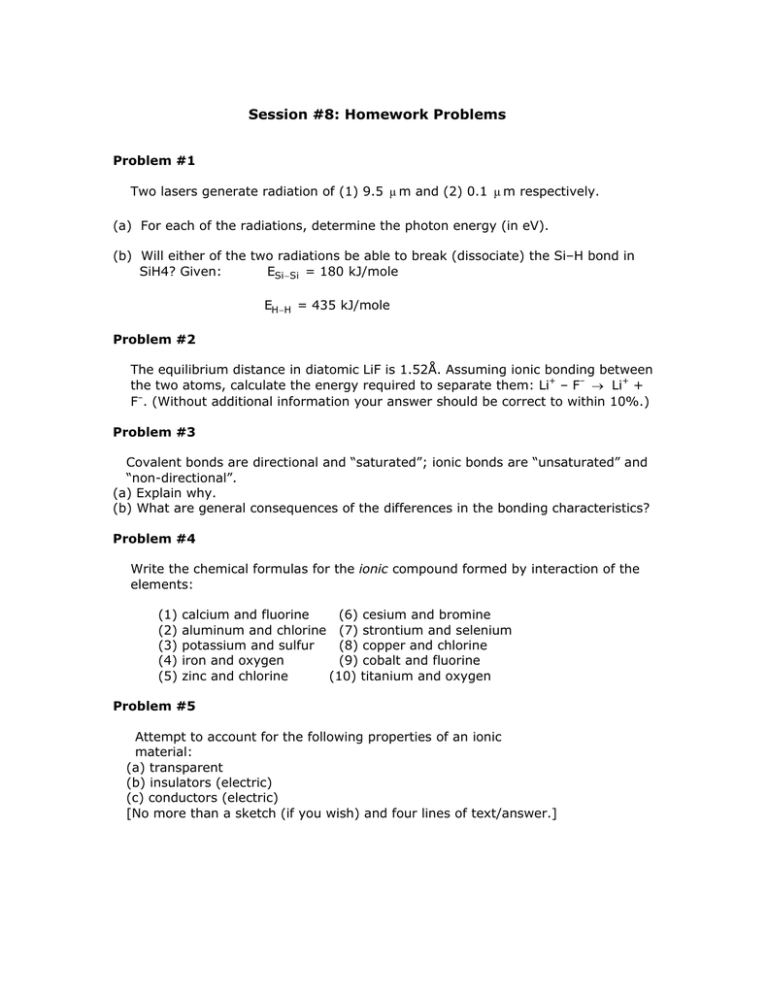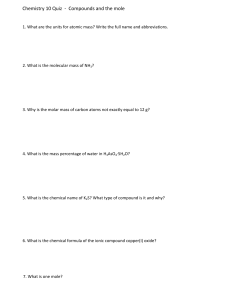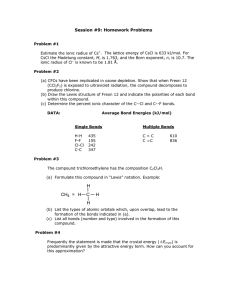Session #8: Homework Problems
advertisement

Session #8: Homework Problems Problem #1 Two lasers generate radiation of (1) 9.5 μ m and (2) 0.1 μ m respectively. (a) For each of the radiations, determine the photon energy (in eV). (b) Will either of the two radiations be able to break (dissociate) the Si–H bond in ESi − Si = 180 kJ/mole SiH4? Given: EH −H = 435 kJ/mole Problem #2 The equilibrium distance in diatomic LiF is 1.52Å. Assuming ionic bonding between the two atoms, calculate the energy required to separate them: Li+ – F– → Li+ + F–. (Without additional information your answer should be correct to within 10%.) Problem #3 Covalent bonds are directional and “saturated”; ionic bonds are “unsaturated” and “non-directional”. (a) Explain why. (b) What are general consequences of the differences in the bonding characteristics? Problem #4 Write the chemical formulas for the ionic compound formed by interaction of the elements: (1) (2) (3) (4) (5) calcium and fluorine (6) cesium and bromine aluminum and chlorine (7) strontium and selenium potassium and sulfur (8) copper and chlorine iron and oxygen (9) cobalt and fluorine zinc and chlorine (10) titanium and oxygen Problem #5 Attempt to account for the following properties of an ionic material: (a) transparent (b) insulators (electric) (c) conductors (electric) [No more than a sketch (if you wish) and four lines of text/answer.] Problem #6 Hydrogen and selenium react with each other to form a compound. (a) What is the chemical formula of the compound? (b) At room temperature, do you expect this compound to be a solid, a liquid or a gas? Substantiate your answer. Problem #7 (a) Determine the differences in relative electronegativity ( Δ x in eV) for the systems H–F and C–F given the following data: Bond Energy H2 F2 C-C H-F C-H kJ/mole 436 172 335 565 410 (b) Taking XH = 2.1, determine the relative electronegativities (in eV) for C and F. Problem #8 For NaF the repulsive (Born) exponent, n, is 8.7. Making use of data given in your Periodic Table, attempt to calculate the crystal energy ( Δ Ecryst). (What assumption do you have to make to calculate Δ Ecryst?) MIT OpenCourseWare http://ocw.mit.edu 3.091SC Introduction to Solid State Chemistry Fall 2009 For information about citing these materials or our Terms of Use, visit: http://ocw.mit.edu/terms.



